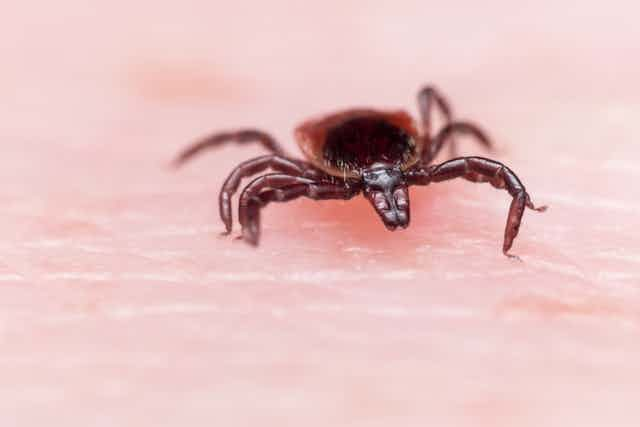Fall has arrived. This is the season that transforms our forests with a beautiful display of colour and fills our kitchens with the smell of pumpkin pie and apple cider. It also brings something far less pleasant to our forests and hiking trails — blacklegged ticks.
In parts of central and eastern Canada, October and November are peak activity times for adult blacklegged ticks or “deer ticks” (Ixodes scapularis). Spring is also a peak time for adult activity, while nymphal blacklegged ticks are active late spring and early summer. This means they are hungry for blood and will climb up onto low lying vegetation in the forest to wait for their meal. This might be a deer or a raccoon — or it could be you, me or our pets.
Aside from the inherent revulsion many people feel towards ticks, some species pose a risk to human and animal health. The blacklegged tick can transmit several pathogens — most notably Borrelia burgdorferi, which can cause Lyme disease in humans, dogs and horses.
Lyme disease in humans is a potentially debilitating disease that can cause long-term symptoms like fatigue, joint pain, arthritis, facial paralysis and neurological disorders if left untreated. In dogs, the most characteristic sign is a shifting lameness, usually accompanied with general malaise. In rare cases, it can lead to a form of kidney failure.
As a veterinarian and researcher, my work focuses on ticks and tick-borne diseases, specifically those that affect both humans and animals. Over the past few years, we have certainly seen dramatic changes in our tick populations in Canada.
While this doesn’t mean we should curtail our outdoor activities, it does mean we need to think much more carefully about tick prevention.
Master hitchhikers
Back in the early 1990s, the blacklegged tick population in Canada was restricted to Long Point, Ont. Over the past few decades, we’ve seen an ongoing expansion of its range with thriving populations now found in many areas of Ontario, Québec, Nova Scotia, New Brunswick and Manitoba.
Ticks — which themselves have very limited movement — are masters at hitching a ride on other animals, particularly migratory songbirds.
Each spring millions of ticks, blacklegged and other species, are introduced into Canada on migratory birds. Not all of these ticks will survive and reproduce but this does provide a seed for population expansion.

Spring bird migration is not a new phenomenon. But what is changing is our climate along with other ecological factors — such as host populations and habitat — that facilitate blacklegged tick survival and population growth.
Sufficient temperature is a basic requirement for many tick species. Temperatures need to be warm enough for long enough so the ticks can feed and undergo development. With climate change, more northern areas are becoming more suitable for blacklegged ticks.
Climate change also impacts forested habitats and the distribution of wildlife species, all of which may further facilitate blacklegged tick range expansion.
New ticks on the block
And it’s not just blacklegged ticks — we’ve seen notable changes in other tick species.
The lone star tick (Amblyomma americanum) has spread dramatically from the southern United States northward. Although no populations are known to exist in Canada, they are frequently introduced on birds. Recent research indicates that many areas are climatically suitable, with the appropriate habitat and hosts to support this tick species.
Last November, an exotic tick species from Asia — the longhorned tick (Haemaphysalis longicornis) — turned up on a sheep farm in New Jersey. It’s now been found in over half a dozen states.
What makes this tick species unique is that an adult female does not need to mate to produce viable eggs. This means a population can quickly become established in a new area following the introduction of this tick.
We do not know if or when these species could arrive in Canada. But, the blacklegged tick has illustrated that we must remain vigilant to monitor the distribution and spread of all ticks.
How to do a full body check
The public plays a large role in monitoring for ticks. Public health officials in many provinces accept tick submissions found on humans — a process called passive surveillance.
Other programs exist through research institutions. Researchers at the Ontario and Atlantic Veterinary Colleges run the Pet Tick Tracker, which accepts submissions of ticks from pets. Dogs are particularly good at picking up ticks from the environment and may provide an early warning signal that disease risk is changing.
eTick is another online platform developed at Bishop’s University where the public can submit a photo of a tick for identification. It is currently only available in Québec but there are plans to expand to other provinces.
Unfortunately, once tick populations establish, it seems like they are here to stay. But this does not mean you should stop going outside and enjoying mother nature. It just means that we need to think more about tick prevention.
There are many things we do to keep ourselves healthy. We wash our hands before we eat and put sunscreen on before going outside. And now when we come back inside, we must do a full body tick check on ourselves and our pets.

